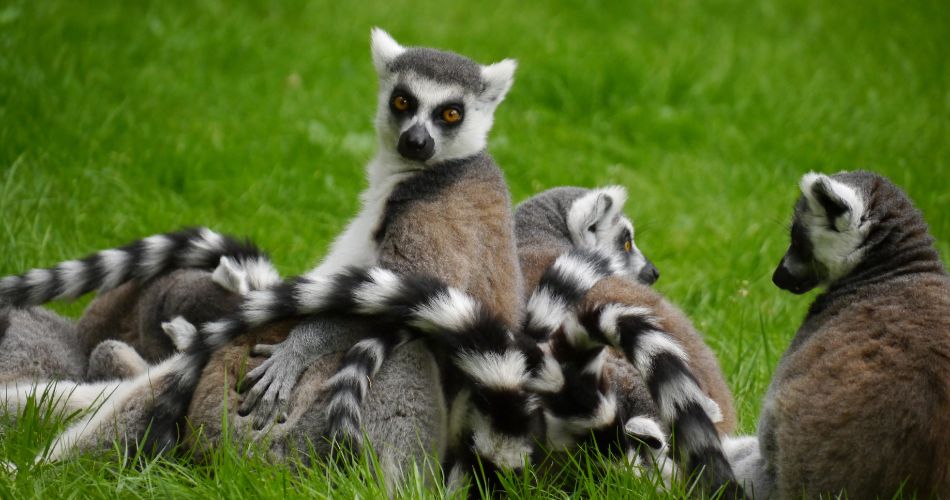World Lemur Day is observed on the last Friday of October each year. It’s a special day to celebrate the remarkable animals known as lemurs, and to raise awareness about their place in the world and the threats they face. 1
Table of Contents
History of World Lemur Day
The origins of World Lemur Day trace back to the island nation of Madagascar, where lemurs are uniquely native. The inaugural celebration of the event (through a larger festival called the World Lemur Festival) was held in 2014 in the capital city of Antananarivo, organized by Professor Jonah Ratsimbazafy of the organization GERP Madagascar. The aim was to awaken both local and global recognition of lemurs as a vital part of Madagascar’s natural heritage and to inspire efforts in conservation and education.
As the years passed, the observance spread beyond Madagascar. Zoos, conservation organizations, schools, and individuals around the world began participating, turning the last Friday of October into a global moment of reflection and celebration of lemurs.
Why is World Lemur Day important?
World Lemur Day reminds us of something both fragile and extraordinary. Lemurs are found only in Madagascar — no other place on Earth harbors them naturally—which makes them a symbol of uniqueness in the animal kingdom. The fact that so many of their species are under serious threat gives the day its urgency. According to scientists, nearly every lemur species is facing declining numbers and habitat loss.
On a human level, this day connects us to a larger story: how the lives of wild creatures and the survival of ecosystems tie into our own. The challenges lemurs face — deforestation, climate change, human encroachment — echo issues many species share, but because lemurs are so uniquely tied to one place, their situation helps us focus in. Instead of a distant crisis, it becomes real, tangible, and locally rooted.
Here are some of the human‑and‑nature reflections I hold dear on this day:
- It reminds us that biodiversity isn’t just “nice to have”, it’s irreplaceable.
- It shows how one island’s wildlife can speak to global conservation.
- It gives us a chance to link education and fun: learning about lemurs can spark curiosity and action.
- It celebrates the wonder of nature: the long leaps, the social groups, the adorable faces of lemurs remind us why we preserve things in the first place.
- It reminds us of our responsibility — not just to animals we adore, but to habitats and ecosystems we might not usually think about.
How to Observe World Lemur Day
Observing World Lemur Day doesn’t require complicated plans. You can make it meaningful in small, simple ways that feel personal and realistic. For example, you might visit a local zoo or nature center and ask whether they’re doing anything special for lemurs. It could be as easy as sharing something about lemurs on social media—a photo, a fact, or a short video — and using the day to start a conversation with family or friends about conservation.
If you’re feeling creative, you could host a small “lemur hour” at home: pick a documentary about Madagascar and its wildlife, try a lemur‑themed craft (like making a mask or drawing one), or even have a lemur‑inspired snack while you chat about why this matters. These modest actions add up: when many of us do a little, it becomes something bigger.
Here are some doable ideas:
- Go to your local zoo or wildlife sanctuary and ask how they support lemur conservation.
- Post a fun fact about lemurs on your social media, tagging the day and raising awareness.
- Create or print a lemur coloring sheet and use it with kids or friends as a fun learning activity.
- Spend half an hour researching lemurs and Madagascar — their uniqueness, the challenges they face — and share what you learn with someone else.
- Choose a lemur species to “adopt” (symbolically) through a conservation program and learn more about their habitat and threats.
Interesting facts about lemurs

- Lemurs are found only on the island of Madagascar (and some nearby islands) in the wild.
- There are over 100 distinct species of lemurs — around 112 species are currently known.
- Their evolutionary ancestors likely rafted across an ancient ocean from mainland Africa to Madagascar around 60 million years ago.
- One of the world’s smallest primates is a lemur: the tiny mouse lemur weighs only around 30 g.
- Lemurs fill an extraordinary variety of ecological niches on Madagascar — from rainforests to dry spiny deserts — because they evolved in isolation without the competition from monkeys and apes.
- On the other end of the size spectrum, some extinct lemur species weighed up to ~160-200 kg and no longer exist today.
- Some lemurs exhibit hibernation-like behaviour (torpor) — unusual among primates. For example, dwarf lemurs can hibernate for months.
- Many lemur species are highly endangered: around 95% of known lemur species are at risk of extinction.
- Lemurs play a critical ecological role: for example, they disperse seeds from the fruits they eat, helping to regenerate Madagascar’s forests.
- The name “lemur” comes from the Latin lemures meaning “spirits of the night” (because their large eyes and nocturnal habits reminded early naturalists of ghosts).
Subscribe to our newsletter and never miss a holiday again!

